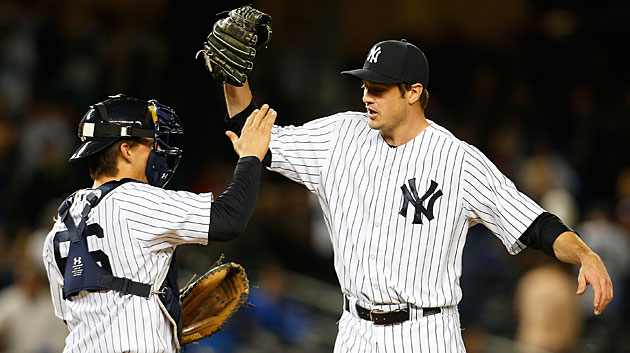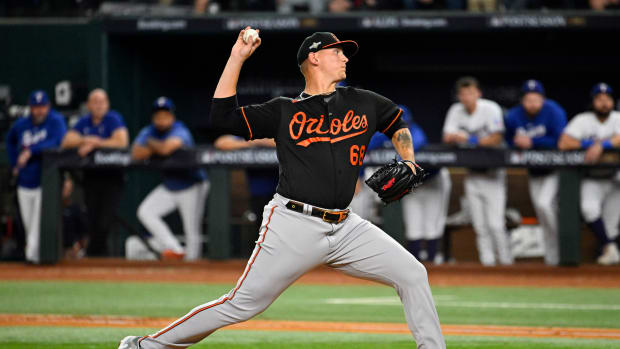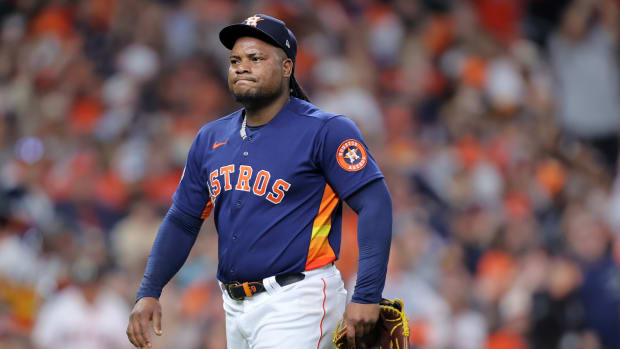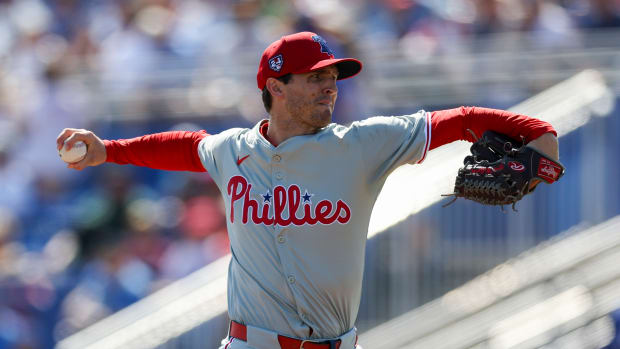A-Rod, Astros, Trout and mighty 'pens among early trends to watch
Nobody should draw conclusions after one month. A reminder: half the teams in playoff position last year at the end of April were nowhere to be seen when the playoffs began (the Braves, Brewers, Mets, Rangers and Yankees). But one month is enough time to identify trends. And here are your 10 most interesting trends from the first month of baseball.
1. The market correction is nowhere to be seen.
Forget about hitters bunting against the shift, using the whole field and adopting a two-strike approach. Pitchers—with more pure stuff than ever before—still dominate baseball, even with a tiny uptick in runs this April compared to last (.06 per team per game). Compared to other Aprils in baseball history, this latest one gave us:
• The greatest strikeout-to-walk rate ever (2.52).
• The lowest WHIP since 1972 (1.283).
• The fewest hits per game since 1972 (8.44 per team).
• The worst on-base percentage since 1981 (.315).
• The worst OPS since 1992 (.705).
• The pace of action—balls in play, scoring threats, etc.—will continue to dry up.
2. Relief pitching is too good.
David Ortiz on Cubs' Kris Bryant and why hitting is harder than ever
In just six years the April batting average against relief pitchers has dropped from .260 to .233. Two-thirty-three! Here’s another way to look at how the surplus of hard-throwing specialists is draining offense (and comebacks) out of the game: It is harder to hit against bullpens today (.233) than it was to hit against all pitchers in 1968, the sport’s infamous nadir of offense (.237).
The average major league game in April included 8.12 pitchers, a record volume, and a 47 percent increase since then Oakland manager Tony LaRussa started Bullpen Madness when he deployed Dennis Eckersley as his full time closer in 1988 (5.50 per game).
Now teams have multiple pitchers with “closer’s stuff.” Led by Dellin Betances and Andrew Miller, the New York Yankees’ bullpen has joined the Kansas City Royals’ bullpen as the game’s elite pens. In April, batters hit .159 against Yankees relievers and .151 against Royals relievers.
How much do bullpens rule baseball? Five teams posted a bullpen ERA in April better than 2.50. Here are those teams and where they stood in the standings at the end of the month:
Team | Bullpen ERA | STANDING |
Royals | 1.02 | Division leader |
Cardinals | 1.59 | Division leader |
Yankees | 1.75 | Division leader |
Astros | 2.18 | Division leader |
Dodgers | 2.25 | Division leader |
3. Mike Trout is too good.
Trout told me that in his entire minor league career (1,312 plate appearances) he never swung at the first pitch of an at-bat. It was his forced way of learning plate discipline.
Trout didn’t change much as a big leaguer, which is one reason why he whiffed a league-worst 184 times last year; he gave away too many free strikes to pitchers. Now Trout is changing his ways. While he may have only one first-pitch hit this year, the biggest difference in Trout’s game is that he has virtually doubled the rate that he hacks at first pitches, from 11% to 21%. He also has cut down on conceding strikes—his rate of strikes looking has dropped from 36 percent to 26 percent.
April All-Stars: Stanton, Cruz, Archer lead way as month's top players
The result? Trout is more dangerous than ever. He cut his strikeout rate while he posted a career high 1.039 OPS for April. And once again he leads the league in runs scored. Trout could become the first player ever to lead the league in runs for four consecutive seasons.
“He’s more aggressive if he feels the situation is right and he knows the pitcher,” Angels manager Mike Scioscia said. “Last year he would take the first pitch and foul off the next pitch and before you knew it he was 0-and-2. Now when he’s comfortable and knows the pitcher and knows the situation, he’s letting it go.”
What you’re seeing is growth. The author Malcolm Gladwell wrote in Outliers that it takes 10,000 hours worth of practice to show mastery in a field. For Trout, the mastery comes from 10,000 pitches. Trout already was the best player in baseball with the best set of skills in baseball. But now to that superior talent you add the wisdom gleaned from seeing almost 10,000 major league pitches. The result is a smarter, shrewder Trout taking his game to an even higher level.
4. Momma, don’t teach your kid to throw splits.
Among the six starting pitchers who used a split-fingered fastball most often in April, all six of them previously suffered a torn UCL in their pitching elbow: Alfredo Simon (hurt in 2009), Masahiro Tanaka (2014), Mike Pelfrey (2012), Jason Marquis (2013), Miguel Gonzalez (2009) and Tim Hudson (2009).

With closer Andrew Miller anchoring their stellar bullpen, the surprising Yankees are in first place.
Mike Strobe/Getty Images
5. Alex Rodriguez still can turn on a fastball.
For 17 months of forced inactivity, the only “live” pitching Rodriguez saw was from soft-tossing Freddy Garcia for some batting practice sessions. So one of the biggest surprises of April is that at age 39 and without seeing major league velocity for a year and a half, Rodriguez has been a better fastball hitter than when we last saw him in 2013.
Rodriguez slugged .767 against four-seam fastballs in April. Among the 23 times he made contact with four-seamers, Rodriguez smashed five home runs, a double and a single. Pitchers who once pounded him in with fastballs are getting hip to The Unnatural. Rodriguez now is seeing his lowest percentage of hard stuff in the eight recorded years of Pitch F/X (61%).
Rodriguez has become a different hitter. He is no longer a great hitter, but he is a threat, which shows in how pitchers are approaching him. His contact rate is the worst it’s been in at least 14 years, his strikeout rate is the worst it’s been since he was a teenager, and yet his walk rate is higher than ever before. He is a righthanded Adam Dunn, king of the three true outcomes (home runs, strikeouts and walks).
April non-stars: Choo, Utley among those hoping for brighter days
Oh, and one more difference: Rodriguez flat out ambushed Boston reliever Junichi Tazawa for home run 660 last Friday. Until that homer, Rodriguez did not have a hit on a 3-and-0 pitch since 2009. In his career he had seen 668 pitches on 3-and-0 counts and swung at only 48 of them. What that means is that over his career Rodriguez looked at 3-0 pitches 93 percent of the time, choosing to swing only about twice every season. So Tazawa grooved a fastball—and got a good look at the new, fastball-chomping version of Rodriguez.
6. The almighty pitch count is gaining even more muscle.
What used to be a guideline is becoming a de facto rule. Check out how many times a manager allowed a pitcher to throw 120 pitches in April over the past 10 seasons:
2006: 14
2007: 6
2008: 8
2009: 6
2010: 10
2011: 11
2012: 8
2013: 5
2014: 8
2015: 1
Only Johnny Cueto of Cincinnati was allowed to throw 120 pitches in a game this April. Reds manager Bryan Price should expect to hear from the Pitch Count Police any day now. Go back another 10 seasons, to 1996, and pitchers threw 120 pitches in an April game 50 times!
7. The complete game is becoming extinct.
April saw only five complete games. That’s half of what was the previous historic low for the month (10 in 2006; excluding the 1995 strike year).
8. The sacrifice bunt also makes the endangered list.
The rate of sac bunts is at an all-time low in the 121 years of recorded history. You might think in a run-depressed environment that smallball might make a comeback, but a generation of front office executives has grown up thinking the bunt is evil; that the life of your team within a game is tied to the number of outs you get, so giving one up on purpose is anathema.
Sacrifice bunts by position players are down 30% from 1998, when runs were much easier to come by.
9. A is for awful.
Chris Iannetta had the seventh-worst April in the past century among all hitters with at least 50 at-bats in the month. The Angels catcher hit .093 (5-for-54). The all-time worst April? That belongs to his hitting coach. Don Baylor hit .062 (4-for-65) for the 1981 Angels.
“I hated April. Hated it,” Baylor said. “I never did well in April. The only thing I remember from that year was one time we were playing in Oakland and we had runners on first and second, no outs and I had a full count. We started the runners, and I smoked a line drive—right to the shortstop. One, two, three … triple play. That’s why when I became a manager, I never started the runners on a full count with runners on first and third. I didn’t want to see another triple play.”
10. The Astros are the biggest story in baseball.
Power Rankings: Red-hot Astros rise, struggling White Sox plummet
Yes, the franchise that over the previous four seasons averaged 104 losses—and lost 33 more games than any other team in those years—is not only leading the AL West but is doing so by the largest margin (seven games) in the majors. Houston is putting up some ridiculous numbers that are not sustainable: 10-2 on the road, 6-1 in one-run games, 3-0 in extra-inning games, only one blowout loss (by at least five runs) in 25 games … and its offense is, well, let’s just call it extreme.
The Astros are a home run hitting team built to launch balls in the air (only the Yankees hit a greater percentage of flyballs) when they make contact. And Houston is 11-0 when it hits at least two dingers in a game.
The down side to the Astros' launch-pad approach comes when their hitters don’t make contact, which is very often. Houston is on pace to whiff 1,497 times, which would be the third most ever. Six teams in baseball history have struck out more than 1,400 times (all of them in the previous five years). All six teams not only finished with a losing record, but also averaged 95 losses.


































